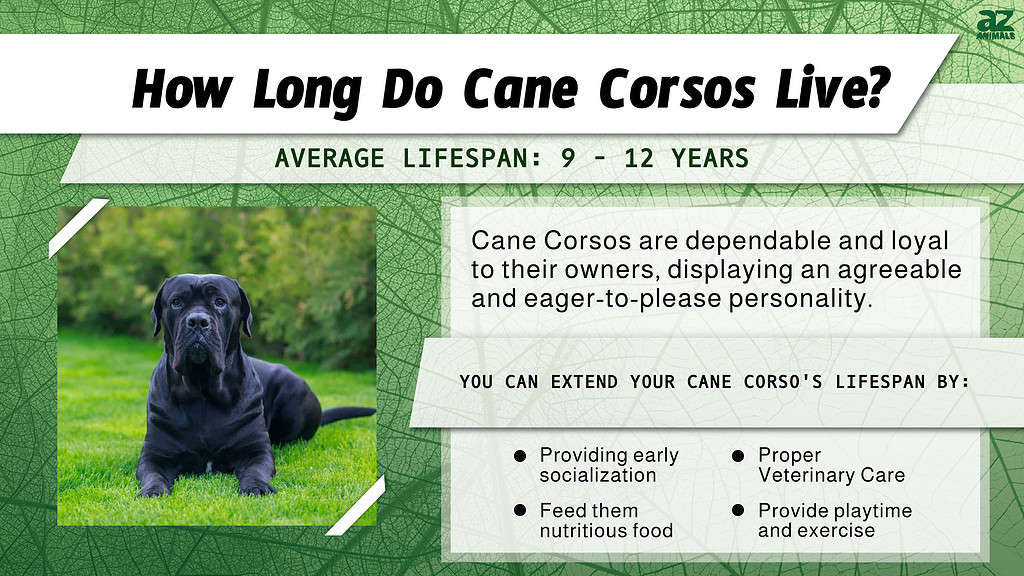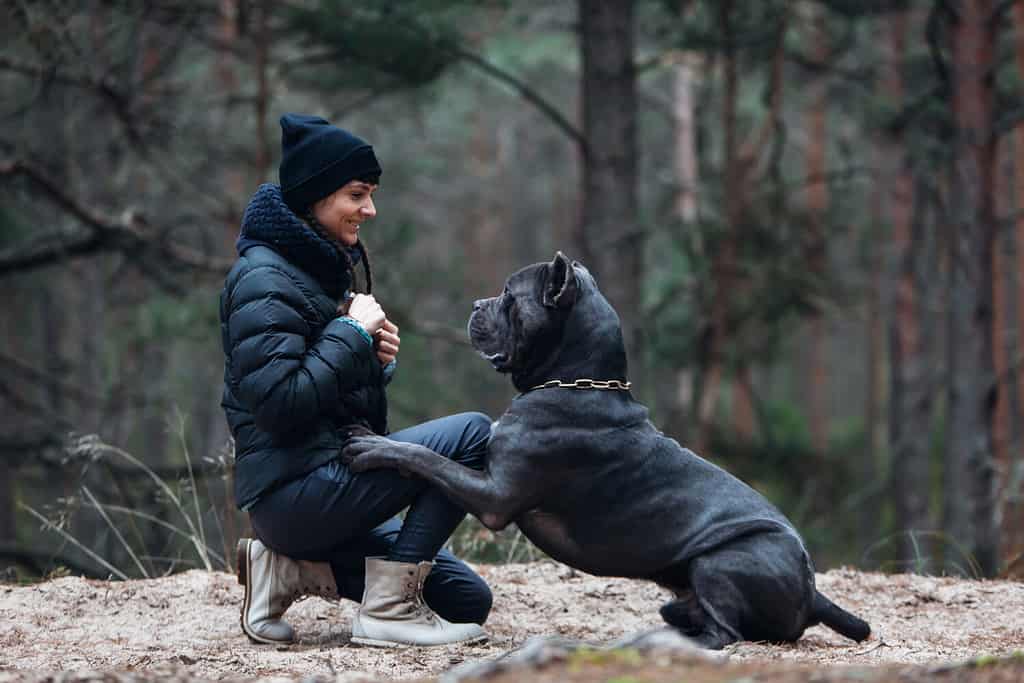These affectionate pups have a stunning appearance and a protective nature. With their fierce loyalty and high intelligence, they’re sure to fill your home and heart with years of fruitful challenges and genuine emotional resonance. But exactly how many years do you get with this giant breed? Learn about the Cane Corso lifespan, including what factors influence their longevity!
Cane Corso Overview
The Cane Corso is known for its intelligence and affectionate nature. These dogs operate with confidence and respond well to training. They are assertive and stand proud with a regal quality to their appearance. They are dependable and loyal to their owners, displaying an agreeable and eager-to-please personality. However, with an owner who does not properly train and socialize their pup, the Cane Corso’s assertiveness can cause a dynamic shift that leaves the owner outsmarted.

Cane Corsos are giant breed dogs born with floppy ears. Ear cropping is unnecessary and painful.
©Sbolotova/Shutterstock.com
The Cane Corso is a large, protective guard dog that needs early socialization. They typically grow to about 28 inches tall at the shoulder and can grow to weigh over 100 pounds. They have an alert expression with floppy ears on either side of their heads. Unfortunately, their ears are often cropped solely to manipulate their natural appearance. Their heads are large, and their short coats reveal their naturally muscular build. Their appearance alone is enough to deter intruders — they have the classic bodyguard stance and presence built in. It’s no wonder, seeing as their name originates from ancient Roman times and has a rough translation to “bodyguard dog.”
What Is the Average Life Expectancy for a Cane Corso?

A Cane Corso has a life expectancy of nine to 12 years. You can promote a healthy life for your pup by being mindful of every aspect of their life, from nutrition and exercise to grooming and training. Their food should be high quality and always specially formulated for their age. These are large dogs that often weigh over 100 pounds but too many calories can still lead to obesity, which only adds to the pressure on their joints and can cause injuries and health conditions in their adulthood and senior years.
When you provide adequate nutrition and access to fresh, clean water daily, you can expect a pup that has the foundation it needs to thrive. Generally, Cane Corsos lead healthy lives, especially if they come from a responsible breeder. This is because responsible breeders take extra care to screen for any abnormalities and health conditions. When under your care, be sure to check your Cane Corso’s ears as part of their regular grooming. This ensures they don’t develop an infection without you noticing it right away. Additionally, be sure to brush your Cane Corso’s teeth to keep up with their oral health.
Healthy Activities for a Cane Corso
It’s not just your gentle yet assertive training that keeps Cane Corsos at their best. They also need to partake in healthy activities to have a proper outlet for their energy. There are low-cost and relatively easy ways to go about this as well as some that require an investment and a more serious time commitment. For example, a protection sport is a type of technical training that plays to your Cane Corso’s natural abilities. To engage in this type of activity, you could join a club and have your pup evaluated for a variety of skills, including protection and obedience.
For easier activities, try dog sledding or dock jumping. If you live in a climate that receives snow, dog sledding can be the perfect activity that caters to your Cane Corso’s natural pulling instincts. You get to get in on the fun, too, since your adult pup is strong enough to pull you along for a ride! Dock diving is best done on a warm, sunny day. Your Cane Corso loves expending energy trying new activities and dock jumping provides them with the perfect opportunity. All you need is a floating toy and a safe environment like a lake. It’s basically a game of fetch but your pup gets a much more enriching experience.

Cane Corsos need plenty of physical and mental stimulation to thrive.
©BoJack/Shutterstock.com
For something even easier you can do at home, try some nose work. This involves the use of some of your pup’s favorite treats. Simply hide them in different spots in your open living room area or your large backyard. Avoid leaving any other heavily scented items in the area so your pup can zero in on the treats. This keeps them busy and mentally stimulated and doesn’t require you to drive anywhere. Even hide-and-seek works with Cane Corsos! A mix of at-home activities with outdoor activities keeps Cane Corsos healthy and fulfilled.
Common Health Issues for a Cane Corso
Like other giant breed dogs, Cane Corsos have a susceptibility to developing a few health issues. However, knowing what they are can put you in an optimal position to work with your veterinarian on preventive measures. Some of the most common health issues for a Cane Corso include:
Hip Dysplasia
With giant dogs, there is a lot of weight and pressure put on their joints. Over time, their hip joints break down, which causes grinding and rubbing. This is a painful condition that results in limping, stiffness, and reduced muscle around the hips.
Arthritis
This condition also affects your Cane Corso’s joints. They breakdown and become inflamed with use over time, which gravely impacts your pup’s quality of life. Obesity is Cane Corsos can precede this condition, which means you can work toward preventing its early development by keeping your pup at a healthy weight.
Epilepsy
This is a neurological condition that results in seizure episodes. Veterinarians are not aware of the cause of this condition in Cane Corsos but it does appear to be a genetic condition. Typically, if a Cane Corso develops this condition, it occurs around age two or three. Luckily, however, the condition can be managed with veterinary care and prescription medication.
Entropion
This condition occurs when your Cane Corso’s eyelids roll inward, which results in their eyelashes upsetting the cornea. This can result in corneal ulcers, which are lacerations to the corneal layer. This requires immediate veterinary care as the condition can quickly worsen. Eye surgery is often recommended to correct this condition.
Ectropion
This condition also affects the eyelids. However, instead of rolling inward, they roll outward. You can typically spot this condition when you look at your Cane Corso and their eyes look a bit droopy. They may also be irritated, and red. Eye drops can help with lubrication since they can get quite dry with this condition.
Cane Corso Lifespan Study
Interestingly, the coat color of a Cane Corso has been shown to influence its life span. A study on the relationship between coat color and Cane Corso longevity found that black brindle and brindle Cane Corsos have a longer lifespan than those with other coat colors. These dogs were found to live a little over 10 years each.
Fun Facts About the Cane Corso
1. They’re Emotionally Attuned to You
Your Cane Corso isn’t just protective of your home and family, but also of your emotions. They can tell when you’re down and they may even think they had something to do with your mood shift. There’s a beautiful emotional depth that comes with owning a Cane Corso that may surprise and impress you.
2. They’re Chatty
These are vocal pups that howl and snort to communicate with you. They also make a distinctive “roo-roo” sound you’ll come to know and love.
3. They Love a Challenging Job
Cane Corsos need both physical and mental stimulation. They need a challenging job to complete. It can be something arduous outdoors or you can even assign them tasks to help with family members in the home, including children.
The photo featured at the top of this post is © Sbolotova/Shutterstock.com
Ready to discover the top 10 cutest dog breeds in the entire world?
How about the fastest dogs, the largest dogs and those that are -- quite frankly -- just the kindest dogs on the planet? Each day, AZ Animals sends out lists just like this to our thousands of email subscribers. And the best part? It's FREE. Join today by entering your email below.
Thank you for reading! Have some feedback for us? Contact the AZ Animals editorial team.






